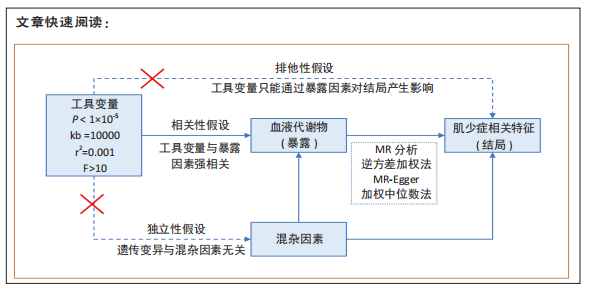中国组织工程研究 ›› 2025, Vol. 29 ›› Issue (在线): 1-11.
• •
基于孟德尔随机化分析欧洲人群代谢物与肌少症的因果关系及其代谢物与 心血管疾病的相关性分析
陈佳永1,唐梅玲2,卢健棋2,*,庞 延2,杨尚冰1,毛美玲1,罗文宽1,陆 微1
- 1广西中医药大学,广西南宁,530200;2广西中医药大学第一附属医院,广西南宁,530022
Based on Mendelian randomization, the causal relationship between 1400 metabolites and sarcopenia and the correlation analysis of cardiovascular disease were investigated
Chen Jiayong1, Tang Meiling2, Lu Jianqi2, Pang Yan2, Yang Shangbing1, Mao Meiling1, Luo Wenkuan1, Lu Wei1, Zhou Jiatan1
摘要:

文题释义:
孟德尔随机化:是目前在流行病学研究中用来推断疾病因果关系的一种成熟的统计分析方法。该方法将遗传变异作为工具变量对暴露因素和结局之间存在的因果关系进行检验,与临床随机对照试验设计方案中的随机分组相类似。其优势在于遗传变异固有的稳定性能够克服潜在的混杂因素和传统观察性研究的影响。肌少症:是以进行性的全身性骨骼肌力量及质量下降、功能障碍为主要特征的退行性病变,通常随着年龄的增长而发生,严重危害老年人群的健康生活。
背景:国内外研究均表明肌少症(sarcopenia,SP)与代谢物有着紧密联系,目前最新的1 400种血液代谢物与肌少症之间的联系尚不明。
目的:本研究运用孟德尔随机化(MR)分析1 400种代谢产物与肌少症之间存在的因果关系及其引发心血管疾病的相关性。
方法:从open gwas网站获取肌少症相关特征(握力、四肢肌肉瘦体重、步行速度)的全基因组关联研究(GWAS)数据作为结局数据。一项包含1 400种代谢产物的GWAS作为暴露因素,选择与暴露因素显著相关的SNPs作为工具变量(IV)。借助R软件(V4.3.2)的“TwoSampleMR”、“gwasglue”等包对1 400种代谢产物与肌少症之间存在的因果关联进行分析。研究的方法涉及逆方差加权法(IVW)、MR-Eggeer回归截距、加权中位数法(WM)、简单模式(Simple mode)等5种方法。并进行异质性、多效性、敏感性等验证分析。最后进行反向MR分析。
结果与结论:通过IVW分析1 400中血清代谢产物与肌少症之间的因果关系,结果显示,“1-亚油酰基-2-亚油酰基-GPC (18∶2/18∶3)”、 “甘氨脱氧胆酸-3-硫酸酯”是保护因素,随着代谢物的增加疾病的发病风险降低(P < 0.01)。两种未知代谢物(X-12822、X-15486)和“反式3,4-亚甲基庚酸酯”是危险因素,随着两种未知代谢物(X-12822和X-15486)的增加,男性手握力低的程度随之增加;同样,随着“反式3,4-亚甲基庚酸酯”的增加,疾病发病风险也随之增加(P < 0.01)。“1-亚油酰基-2-亚油酰基-GPC (18∶2/18∶3)”、“甘氨脱氧胆酸-3-硫酸酯”对肌少症具有抑制作用;两种未知代谢物(X-12822、X-15486)和“反式3,4-亚甲基庚酸酯”具有促肌少症作用。这可能是未来肌少症研究和治疗的新思路、新依据。
中图分类号: